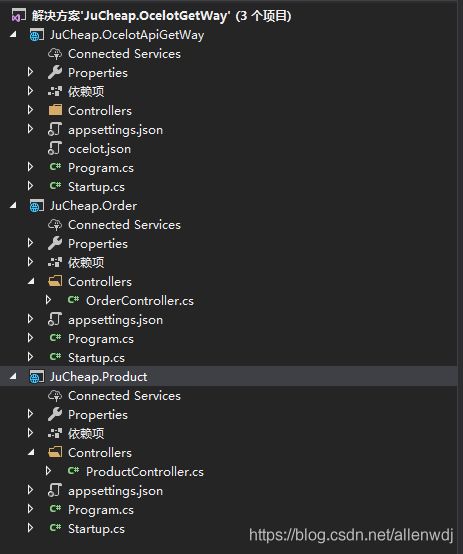net core 中Ocelot webapi getway入门实践(一)
1.Ocelot介绍
Ocelot是一个.net core框架下的网关的开源项目,下图是官方给出的基础实现图,即把后台的多个服务统一到网关处,前端应用:桌面端,web端,app端都只用访问网关即可,如下图:
关于Ocelot的详细使用说明,可以到官网查看:https://ocelot.readthedocs.io/en/latest/。
2.项目搭建
项目使用的visual studio 2017,net core版本是2.2
新建三个net core webapi项目,如下:
JuCheap.OcelotApiGetWay (网关webapi项目),地址:http://localhost:44773
JuCheap.Order (订单系统webapi项目),地址:http://localhost:46237
JuCheap.Product (产品系统webapi项目),地址:http://localhost:46254
api项目的端口可以自己配置,但是需要注意,配置后,需要在ocelot.json文件中,做对应的修改。效果如下图:
3.网关项目配置
在JuCheap.OcelotApiGetWay中引入Ocelot的包,包含Ocelot、Ocelot.Provider.Consul和Ocelot.Provider.Polly,如下图:
新建ocelot.json配置文件,配置文件里面,我们只需要关心如下配置节点:
DownstreamPathTemplate 上游转发到下游的url地址(也就是我们的目标api的地址,比如产品系统的api或者订单系统的api)
UpstreamPathTemplate 上游api路由模板地址
UpstreamHttpMethod 上游支持的请求方式
DownstreamScheme 下游的http头
DownstreamHostAndPorts.Host 下游的api Host
DownstreamHostAndPorts.Port 下游的api端口
ocelot.json的完整代码如下:
{
"GlobalConfiguration": {
"RequestIdKey": "OcRequestId",
"AdministrationPath": "/admin"
},
"ReRoutes": [
{
"DownstreamPathTemplate": "/{url}",
"UpstreamPathTemplate": "/order/{url}",
"UpstreamHttpMethod": [
"Get"
],
"AddHeadersToRequest": {},
"AddClaimsToRequest": {},
"RouteClaimsRequirement": {},
"AddQueriesToRequest": {},
"RequestIdKey": "",
"FileCacheOptions": {
"TtlSeconds": 0,
"Region": ""
},
"ReRouteIsCaseSensitive": false,
"ServiceName": "",
"DownstreamScheme": "http",
"DownstreamHostAndPorts": [
{
"Host": "localhost",
"Port": 46237
}
],
"QoSOptions": {
"ExceptionsAllowedBeforeBreaking": 0,
"DurationOfBreak": 0,
"TimeoutValue": 0
},
"LoadBalancer": "",
"RateLimitOptions": {
"ClientWhitelist": [],
"EnableRateLimiting": false,
"Period": "",
"PeriodTimespan": 0,
"Limit": 0
},
"AuthenticationOptions": {
"AuthenticationProviderKey": "",
"AllowedScopes": []
},
"HttpHandlerOptions": {
"AllowAutoRedirect": true,
"UseCookieContainer": true,
"UseTracing": true
},
"DangerousAcceptAnyServerCertificateValidator": false
},
{
"DownstreamPathTemplate": "/{url}",
"UpstreamPathTemplate": "/product/{url}",
"UpstreamHttpMethod": [
"Get"
],
"AddHeadersToRequest": {},
"AddClaimsToRequest": {},
"RouteClaimsRequirement": {},
"AddQueriesToRequest": {},
"RequestIdKey": "",
"FileCacheOptions": {
"TtlSeconds": 0,
"Region": ""
},
"ReRouteIsCaseSensitive": false,
"ServiceName": "",
"DownstreamScheme": "http",
"DownstreamHostAndPorts": [
{
"Host": "localhost",
"Port": 46254
}
],
"QoSOptions": {
"ExceptionsAllowedBeforeBreaking": 0,
"DurationOfBreak": 0,
"TimeoutValue": 0
},
"LoadBalancer": "",
"RateLimitOptions": {
"ClientWhitelist": [],
"EnableRateLimiting": false,
"Period": "",
"PeriodTimespan": 0,
"Limit": 0
},
"AuthenticationOptions": {
"AuthenticationProviderKey": "",
"AllowedScopes": []
},
"HttpHandlerOptions": {
"AllowAutoRedirect": true,
"UseCookieContainer": true,
"UseTracing": true
},
"DangerousAcceptAnyServerCertificateValidator": false
}
]
}
然后将配置文件加入到WebHostBuilder中,找到Program.cs文件的Main方法,如下:
using System;
using System.Collections.Generic;
using System.IO;
using System.Linq;
using System.Threading.Tasks;
using Microsoft.AspNetCore;
using Microsoft.AspNetCore.Hosting;
using Microsoft.Extensions.Configuration;
using Microsoft.Extensions.Logging;
using Ocelot.Middleware;
using Ocelot.DependencyInjection;
namespace JuCheap.OcelotApiGetWay
{
public class Program
{
public static void Main(string[] args)
{
CreateWebHostBuilder(args)
.ConfigureAppConfiguration((hostingContext, config) =>
{
config
.SetBasePath(hostingContext.HostingEnvironment.ContentRootPath)
.AddJsonFile("appsettings.json", true, true)
.AddJsonFile($"appsettings.{hostingContext.HostingEnvironment.EnvironmentName}.json", true, true)
.AddJsonFile("ocelot.json")
.AddEnvironmentVariables();
})
.Build().Run();
}
public static IWebHostBuilder CreateWebHostBuilder(string[] args) =>
WebHost.CreateDefaultBuilder(args)
.UseStartup();
}
}
在Startup.cs文件中,配置Ocelot的服务,在ConfigureServices方法里面新增如下代码:
services.AddOcelot(Configuration).AddConsul().AddPolly();并在Configure方法里面启用Ocelot网关服务,代码如下:
app.UseOcelot().Wait();Startup.cs完整代码如下:
using Microsoft.AspNetCore.Builder;
using Microsoft.AspNetCore.Hosting;
using Microsoft.AspNetCore.Mvc;
using Microsoft.Extensions.Configuration;
using Microsoft.Extensions.DependencyInjection;
using Ocelot.DependencyInjection;
using Ocelot.Middleware;
using Ocelot.Provider.Consul;
using Ocelot.Provider.Polly;
namespace JuCheap.OcelotApiGetWay
{
public class Startup
{
public Startup(IConfiguration configuration)
{
Configuration = configuration;
}
public IConfiguration Configuration { get; }
// This method gets called by the runtime. Use this method to add services to the container.
public void ConfigureServices(IServiceCollection services)
{
services.AddOcelot(Configuration).AddConsul().AddPolly();
services.AddMvc().SetCompatibilityVersion(CompatibilityVersion.Version_2_2);
}
// This method gets called by the runtime. Use this method to configure the HTTP request pipeline.
public void Configure(IApplicationBuilder app, IHostingEnvironment env)
{
if (env.IsDevelopment())
{
app.UseDeveloperExceptionPage();
}
else
{
// The default HSTS value is 30 days. You may want to change this for production scenarios, see https://aka.ms/aspnetcore-hsts.
app.UseHsts();
}
app.UseOcelot().Wait();
//app.UseHttpsRedirection();
app.UseMvc();
}
}
}
最后将我们的3个api都配置成启动项目,右键点击解决方案,然后找到"属性"->"启动项目",选择多个启动项目栏,把要启动的项目的操作一栏,改成“启动”,如下图:
到此,我们就可以启动项目了,点击菜单栏上的“启动”,我们访问网关项目的如下地址:
http://localhost:44773/order/api/order
http://localhost:44773/product/api/product
效果如下图:
项目源代码:
https://github.com/jucheap/JuCheap.Ocelot




